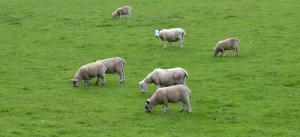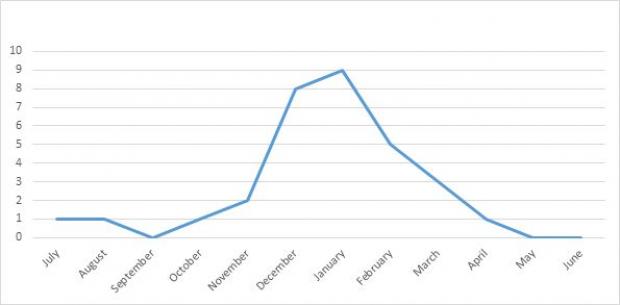Urolithiasis is a disease of economic and welfare importance in ruminant production, particularly on those farms where multiple animals are affected every year.

Urolithiasis occurs when mineral deposits form within the urinary tract leading to uroliths (literally urinary stones) and clinical disease is seen when these deposits lead to partial or complete obstruction of the urinary tract. Uroliths may form in both the male or female urinary tract with equal frequency though clinical disease relating to obstruction or partial obstruction of the urinary tract is much more common in male animals owing to the longer and narrower lumen of the urethra and especially so in young immature or castrated animals.
Cases of urolithiasis in ruminants may commonly affect sheep, cattle or goats but cases recorded in AFBI are seen most frequently in sheep followed by cattle.
Intensive husbandry systems with high levels of concentrate feeding are most frequently associated with urolithiasis. Cereal based diets contain high levels of phosphorus predisposing to urolith formation. Certain sheep breeds such as Texel are more efficient at absorbing dietary phosphorus and excreting phosphorus in urine and may therefore be more susceptible to urolithiasis depending on the management system. As saliva is rich in phosphorus, husbandry systems which encourage rumination and salivation can reduce the risk of urolithiasis by promoting faecal excretion of phosphorus and reducing urinary phosphorus excretion.

Most cases of urolithiasis recorded at AFBI relate to struvite crystals or uroliths composed of magnesium ammonium phosphate. Deposits may be sandy granules or may form stones. Although most cases recorded at AFBI in the period 2008- 2020 were recorded in male animals, a few cases were observed in females. Most cases are recorded during the winter months and are seen in younger animals.
Clinical signs of urolithiasis commonly include dullness, straining to urinate or straining of the anus, inappetance, colic or signs of abdominal pain, kicking at the abdomen and presenting with a hunched back or stiffness. Animals may dribble blood stained urine or mineral crystals may be observed at the prepuce. If the urethra or bladder ruptures there may be swelling of the abdominal floor or of the abdomen. Goats may vocalise loudly.
Medical and surgical treatments are often without success but veterinary attention should be sought because of the substantial welfare implications of disease and also for valuable animals. As urolithiasis is a husbandry disease very often other animals in the batch will be subclinically affected (40-60% of the batch may be subclinically affected) and efforts should be focussed on preventing further clinical cases. Urinary acidifiers such as ammonium chloride may be fed in cases where urolithiasis is due to struvite to lower urinary pH in an attempt to increase solubility of urinary salts. Salt may be included in the diet up to 4% of daily dry matter intake to promote water intake and promote urine production and thus reduce the risk of minerals precipitating out in urine.
On farms where problems occur yearly, efforts should be made to prevent disease. Attention should be given to maintaining good water supply - there should be sufficient water drinkers for the number of animals in the pen, and water drinkers should be at an appropriate height and should be cleaned regularly. Sufficient roughage should be fed to promote salivation. An appropriate breed of animal should be selected for the management system. Castration should not be performed too early on farms which habitually experience problems. Calcium should be supplemented in cereal diets if necessary to maintain the calcium to phosphorus ratio at 2:1 to reduce excess phosphorus absorption and phosphorus should not exceed 0.6% of the diet.
Notes to editors:
AFBI is an arms-length body of DAERA delivering research and development, diagnostic and analytical testing, emergency response capability and expert scientific advice for DAERA and other government departments, public bodies and commercial companies in Northern Ireland, and further afield.
AFBI’s Vision is “Advancing the Local and Global Agri-Food Sectors Through Scientific Excellence”.
AFBI’s core areas:
- Leading improvements in the agri-food industry;
- Protecting animal, plant and human health;
- Enhancing the natural and marine environment.
Latest news
- AFBI issues Nematodirus warning – Spring 2025 11 April 2025
- Managing Nature Based Risks to the UK Economy and Opportunities for Green Finance 08 April 2025
- AFBI Hillsborough host AERA committee 27 March 2025
- The Omics Days Conference 27 March 2025
